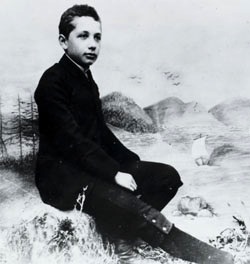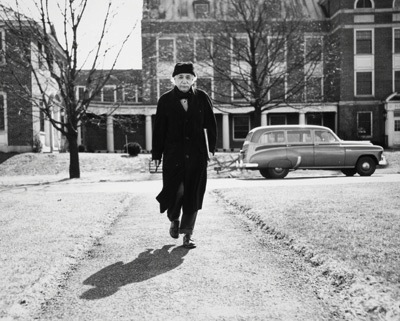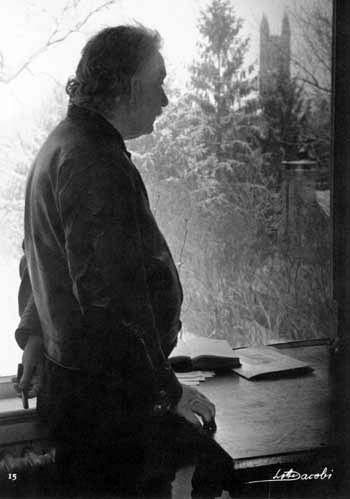
John D. Norton
Department of History and Philosophy of Science
Center for Philosophy of Science
University of Pittsburgh
http://www.pitt.edu/~jdnorton
This text is based on the chapter of the same name in my online textbook, Einstein for Everyone at http://www.pitt.edu/~jdnorton/teaching/HPS_0410/chapters/index.html
Modern day writers often endow Einstein with a 21st century prescience about physical theory that, it just so happens, is only now vindicated by the latest results of the same writers' research. There is a second side to Einstein. His science, methods and outlook were also clearly rooted in 19th century physics.
The Einstein of popular thought is the young Einstein. This is the intellectual rebel of 1905 who, in one year, laid out the special theory of relativity and E=mc2, postulated the light quantum and used Brownian motion to make the case for the reality of atoms. These achievements were made prior to Einstein holding an academic position. He was then still a patent examiner in the Bern patent office. The years that followed brought Einstein a succession of ever more prestigious academic appointments; and, in the mid 1910s, he delivered his masterpiece, the general theory of relativity.

In all this, there was a real sense that Einstein was ahead of his peers, leading the way. The special theory of relativity was absorbed into the mainstream of physics fairly quickly. The general theory of relativity was not quite so readily accommodated. This was in part due to its burdensome mathematical demands of the theory, at least relative to the standards of mathematical expertise then found among physicists. But the tide was flowing with Einstein. When the eclipse expeditions of 1919 vindicated Einstein's theory and he became a popular hero, critics risked being seen as unimaginative reactionaries.
Einstein's work on the light quantum did not fare so well. It was regarded by many as an odd aberration from an otherwise brilliant mind. Even in the early 1920s, it was doubted by Niels Bohr, who had a decade before developed the first quantum model of the atom.
By the end of the 1920s, however, another Einstein began to emerge. As the quantum theory enjoyed success after success, Einstein found himself unconvinced. He took on the role of critic, complaining that the new quantum theory, for all its virtues, could not be the final theory. This was Einstein's new place in the physics community for his final quarter century, ending with his death in 1955. He remained a revered figure. But he became increasingly isolated and marginalized, as he labored on his alternative theories with the help of a few assistants. In the years after his death, it became clear that Einstein's objection to quantum theory failed, but not, I believe, for the reasons articulated by his arch antagonist Niels Bohr.


The old Einstein is a recalcitrant Einstein, unwilling to swim with the new quantum tide that flooded over physics. We should not judge that harshly. No thinker can ever think purely new thoughts. We all sit at the junction of the old and the new. Einstein was one of the first of new physicists of the twentieth century. His discoveries and methods exercised a profound, defining influence on the development of twentieth century physics. However, there is also a strong sense in which he was one of the last of the nineteenth century physicists. Perhaps he was the greatest of them.
Force page break here.
To see why this is not such an unreasonable assessment, we should review the major discoveries and themes of the nineteenth century and then see how they came to be realized and even fulfilled in Einstein's research. We shall look at three categories: Einstein's science, his methods and his outlook.
| 2.1 Science | |
| Nineteenth Century... | Einstein... |
| Electrodynamics The great discovery in physics of the nineteenth century was Maxwell's electrodynamics and its development by later physicists, including H. A. Lorentz. Newton's physics had been very successful in recovering the properties of things like apples and planets that move at ordinary speeds, much less than that of light. Nineteenth century electrodynamics now succeeded in probing the properties of things moving close to the speed of light: charges accelerated to high speeds and light itself. Mixed in were now familiar kinematical effects: rapidly moving systems shrink in length and slow in time; and there are temporal dislocations over space. These were encoded in mathematical transformation equations discovered by H. A. Lorentz and others. |
Special relativity Einstein took special note of the kinematical effects mixed in with the electrodynamical effects of Lorentz's theory. He saw that they could be separated out as a novel theory of space and time, independent of the electrodynamics. The result was the special theory of relativity. Its central equations were the same transformation equations that Lorentz had employed in his development of electrodynamics. Einstein is commonly understood as repudiating nineteenth century electrodynamics in his rejection of its ether. That assessment is altogether too narrow. In extracting the kinematics as an independent theory, Einstein was harvesting one of the greatest fruits of the nineteenth century theory. The ether was merely surplus foliage that needed to be trimmed away during the harvest. The special theory of relativity is the natural completion of nineteenth century electrodynamic theory. |
| Nineteenth Century... | Einstein... |
| Thermal and statistical physics Another significant achievement of nineteenth century physics was the final recognition that thermal processes were to be understood statistically, as the average behavior of systems made of very many components. The simplest case was ordinary matter. It is made of atoms and molecules and heat resides in the energy distributed randomly over them. The same analysis could be given of heat radiation. The many components are the many frequencies that comprise radiation. In all cases, equilibrium thermal systems arise when energy is distributed in its most probable configuration over these components. Probabilities arise merely out of our ignorance of the precise microstate of the system. |
Reality of atoms |
Force page break here.
| 2.2 Methods | |
| Nineteenth Century... | Einstein... |
| Revealing the hidden mechanism Einstein's earliest papers, starting in 1901, were devoted to discovering the discrete molecular mechanisms that underlie the continuity of thermal appearances. That goal is a nineteenth century one: completing the molecular program of Boltzmann. This was work that Einstein largely abandoned. However, during this early work, he developed methods for inferring from the observable thermal properties of substances to their microscopic structure. The easiest and simplest of these was the observation of the ideal gas law in the thermal appearances. Robust argumentation showed that it must derive from a microstructure of very many, spatially localized components. Systems of this simplest type were the ones Einstein investigated in his annus mirabilis of 1905. The tiny particles of Brownian motion form such a system. So do the sugar molecules in dilute solution investigated in his 1905 doctoral dissertation. |
Light quantum When it comes to Einstein's boldest posit, the light quantum, it is easy to find a prescient Einstein, somehow anticipating all the quantum craziness to come. In 1905, in a letter to a friend, Einstein was already calling this one result, among all those of 1905, "very revolutionary." The result was properly called revolutionary when set in the context of electrodynamical theory. For it contradicted the picture of light as a wave whose energy is spread out over space. There is another way to see it, as I reported in the chapter "Atoms and the Quanta." Set in the context of thermal physics, it was less adventurous. Heat radiation is a thermal system. Einstein found in that system the same observable signature of discreteness as he found in ideal gases and dilute sugar solutions. So Einstein merely needed to hold true to the methods he had already developed to infer that heat radiation, under the conditions he specified, consists of many independent, spatially localized units of energy. What results is the light quantum. The result follows from applying his statistical methods to heat radiation. Making sense of that result, however, proved harder and, over a hundred years later, the project remains incomplete. |
| Nineteenth Century... | Einstein... |
| Geometry If the twentieth century was the century of novel physics, the nineteenth century was the century of novel mathematics. Geometry had always been central to science, but it was languishing. Newton's mathematical techniques in his Principia of 1687 would have been immediately intelligible to Euclid himself. That changed in the nineteenth century. There was an explosion of new ideas and methods. One of the foremost achievements of the century was a new conception of geometry. It included the idea of non-Euclidean geometries and their accommodation to yet more sophisticated geometries, notably projective geometry. Felix Klein's "Erlangen Program" unified the many new geometries found in this century by means of another mathematical advance of that century, group theory. |
General relativity Einstein's general theory of relativity provided a qualitatively new way to think about gravity that is Einstein's signature novelty. From a physical point of view, Einstein's theory was a bold departure. From a mathematical perspective, however, it simply applied nineteenth century mathematical techniques to a new and highly interesting application. Where Newton had employed Euclid's mathematics to display his account of gravity, Einstein employed the nineteenth century advances in geometry as the basis of his new theory. The explicit framework was provided by Ricci and Levi-Civita's "absolute differential calculus," now called "tensor calculus." Einstein's mathematician friend, Marcel Grossmann, found Ricci and Levi-Civita's review article of 1901 on the calculus and drew it to Einstein's attention. It provided the framework he needed for his new theory. |
Force page break here.
| 2.3 Outlook | |
| Nineteenth Century... | Einstein... |
| Unification A major theme of nineteenth century physics was the theme of unification. The conception was that all the forces of nature were somehow related and that the burden of physics was to reveal those relations. Nineteenth century physics is punctuated by successful unifications. Electromagnetic theory managed to bring electricity and magnetism together in the one theory. Light then proved to be merely a wave propagating in this electromagnetic field. The single notion of energy unified many powers, such as heat, work and everything into which they may transform. |
Unified field theory Einstein's ambitions clearly held to this goal of unification. He had merged gravitation with the geometry of space and time in his general theory of relativity, completed in 1915. In the decades that followed, he resolved to continue the unification. He now sought a single geometrized theory that embraced both gravity and electromagnetism, his unified field theory. |
| Ether The grounding of nineteenth century electromagnetic theory was the ether. Electric and magnetic fields were not distinct processes, but were merely manifestations of different states of an all-pervading medium, the ether. |
Einstein's metrical "ether" Einstein famously did away with the ether; or, more precisely, he announced it superfluous and railed against the preferred state of rest attributed to it. However, in his general theory of relativity and his unified field theories, Einstein retained an analogous background medium. It was not the ether of the nineteenth century. Rather it was a kind of geometrized version of it: the geometry of spacetime provided a substratum whose properties would be manifested as gravity and electromagnetism. Indeed, as a concession to Lorentz, for a short time around 1920, Einstein talked of the metrical field, the carrier of geometrical properties, as an "ether." |
| Nineteenth Century... | Einstein... |
| Causation The nineteenth century conception of causation was determinism: to say the world is causal is just to say that conditions now fix conditions in the future. This was a bare notion purged of the many finer aspects routinely assumed by a causal metaphysics. Years later, Einstein himself described this nineteenth century conception: "...the laws of the external world were also taken to be complete, in the following sense: If the state of the objects is completely given at a certain time, then their state at any other time is completely determined by the laws of nature. This is just what we mean when we speak of 'causality.' Such was approximately the framework of the physical thinking a hundred years ago." Albert Einstein, "Physics, Philosophy, and Scientific Progress," International Congress of Surgeons, Cleveland, Ohio, 1950; printed in Physics Today, June 2005, pp.46-48. |
Objections to quantum theory Part of the original shock of quantum theory was the sense that its stochastic laws deprived the world of its causal character in this nineteenth century sense. There is a tendency now to discount Einstein's complaint against quantum theory, "God does not play dice." However it was repeated so often by him that we surely must take it as heart-felt. On its face, it is an honest expression of the nineteenth century alarm at the loss of causation.1 Einstein was quite nineteenth century in his expectation that the probabilities of quantum theory would somehow emerge from the supposed incompleteness of quantum description; that was precisely how the probabilities of statistical physics of the nineteenth century arose. Einstein's positive hope was that physics would continue along the lines of his general theory of relativity. Somewhere in his efforts to extend the theory to electromagnetism, Einstein hoped, the odd quantum phenomena would emerge. These hopes hold the quantum up to a nineteenth century ideal of a field theory in which notions of separability and locality are most fully implemented. |
Force page break here.
Imagine that we come to a bend in the road, to use a metaphor of Thomas Kuhn's.2 When we stand at the corner, we see clearly the road that we have passed and also the road that is to come. The bend belongs to both parts. After we have passed the corner, all we see is the new road and the bend that started it. We no longer see earlier part it completed. Einstein is the bend in the road that joins the nineteenth and twentieth centuries of physics.
"...belongs equally to both ..., or it belongs to neither."

This image of Einstein as a transitional figure at the bend in the road seems to me to balance most effectively his connections with the times before and after him. The broader society, both popular and scientific, has found it harder to locate Einstein properly. Time magazine did well when it declared him "Person of the Century" in their last issue of the 20th century of December 31, 1999. That seems fair. However Einstein has also become a prescient figure whose hunches somehow anticipate every modern fad and excitement. "Einstein was right" has become a popular slogan amongst scientists, especially when they want to suggest that Einstein would endorse their latest discovery or conjecture.
Force page break here.
1. It is interesting to speculate on just how much Einstein was troubled by the loss of determinism in quantum theory. Was is as important as his concern that quantum theory was giving up on the notion of a local reality? I'm not sure that Einstein ever makes quite clear in his writings which was the more troubling failing. However we have an indirect report from Wolfgang Pauli, a physicist who knew Einstein well. The following is from a letter Pauli wrote to Max Born on March 31, 1954:
"...Einstein does not consider the concept of 'determinism' to be as fundamental as it is frequently held to be (as he has told me emphatically many times), and he denied energetically that he had ever put up a postulate such as (your [citation to a letter of Born's]): 'the sequence of such conditions must also be objective and real, this is, automatic, machine-like, deterministic'. In the same way, he disputes that he uses as criterion for the admissibility of a theory the question: 'Is it rigorously deterministic?'
Einstein's point of departure is 'realistic' rather than 'deterministic', which means that his philosophical prejudice is a different one..."
Max Born, ed., The Born-Einstein Letters. New York: Walker & Co., 1971.p. 221.
2. Here is Kuhn's writing about Copernicus:
“To ask whether his [Copernicus’] work is really ancient or modem is rather like asking whether the bend in an otherwise straight road belongs to the section of road that precedes the bend or to the portion that comes after it.
From the bend both sections of the road are visible, and its continuity is apparent. But viewed from a point before the bend. the road seems to run straight to the bend and then to disappear; the bend seems the last point in a straight road. And viewed from a point in the next section, after the bend, the road appears to begin at the bend from which it runs straight on.
The bend belongs equally to both sections, or it belongs to neither.”
T. S. Kuhn, Copernican Revolution, p. 182.